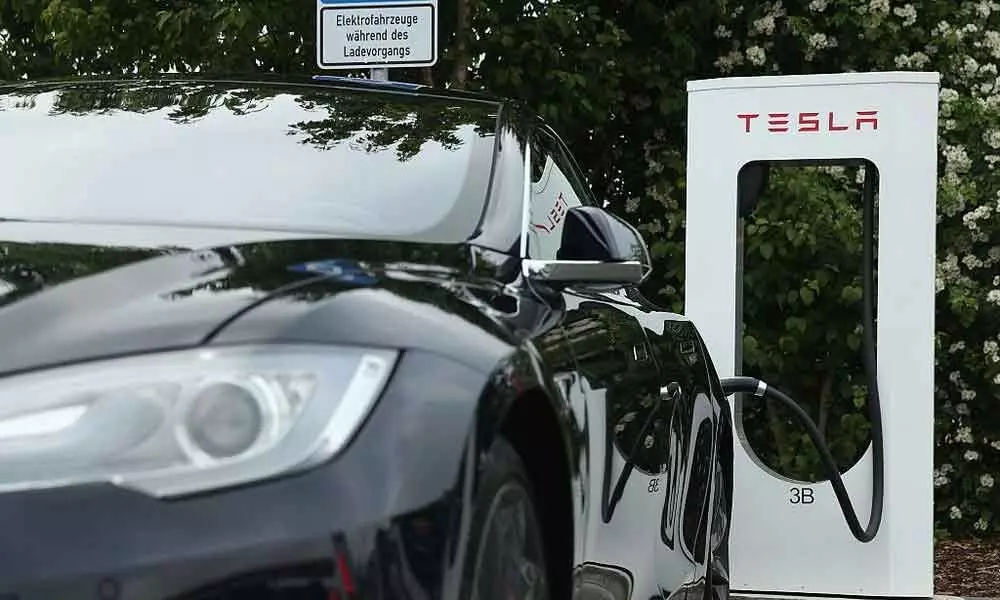How Musk can resolve Texas's power problem?
Tesla is building 2,000 megawatt-hours of stationary energy-storage capability in the state. This can send power to the grid rapidly - which is relevant in light of February’s debacle
image for illustrative purpose

Elon Musk is secretly building a giant battery in Texas. Ultimately, though, it's the other part of Tesla Inc. that could have a bigger impact there.
The scoop on Tesla's hush-hush project near Houston, courtesy of my colleagues at Bloomberg News, landed soon after February's ice-induced blackouts across Texas.
Tesla's effort is part of a small but growing stationary energy-storage capability in the state. Bloomberg NEF counts less than 500 megawatt-hours of capacity currently installed but more than 2,000MW announced or in progress. With the right chemistry and configuration, batteries can send power to the grid rapidly - which is relevant in light of February's debacle.
Power grids run at a certain frequency. There is very little tolerance for deviating from that; a little too high or low and you risk serious damage to generating plants and other equipment.
There was a crucial period of about 15 minutes in the early hours of February 15 where the Texas grid faced outright collapse. Frequency plunged as power plants tripped offline even as demand from freezing Texans was soaring.
This can create a self-reinforcing vortex: As plants switch off for whatever reason, frequency drops, causing other plants to automatically switch off to protect themselves, making the grid even less stable. This is why the grid operator instituted ever bigger blackouts to rebalance supply and demand and prevent an uncontrolled shutdown.
Grid-scale batteries, with enough juice for a few hours, cannot replace power plants for an extended blackout like the one Texas had. At a large enough scale, however, they might have helped to stabilize the grid. The reasons for why specific plants continued to trip offline in the early hours of that Monday are unknown as yet.
Potential causes include lack of fuel, frozen equipment - and automatic shutoff as grid frequency dropped. Batteries might have helped with the latter, stabilizing frequency long enough to prevent automatic shutoffs and thereby avoiding some cutoffs to consumers.
Joshua Rhodes, a research associate at the University of Texas at Austin's Webber Energy Group, raises an intriguing additional possibility. "ERCOT shed a bunch of load so that they could maintain a reserve" of generation capacity during the crisis, he told me.
In theory, if that spare capacity had been charging batteries at scale, it could have been switched into meeting power demand along with batteries discharging onto the grid. "You could have sort of a double boost," he says. In this crisis, when generation outages peaked at 48 gigawatts early on February 16, the sheer scale of the challenge means more stationary storage may only have alleviated things at the margin.
Texas' wealth of wind and solar power potential means projects such as Musk's secret battery will proliferate, crisis or no, as they help with intermittency. But as the state weighs the costs of different ways of strengthening its grid, it should remember that other, far bigger operation Tesla runs: electric vehicles.
A charged-up electric vehicle that isn't on the road is a potential power source. A 60 kilowatt-hour car battery - as you might find in some Tesla Model 3s or Nissan Leafs - could power the average home in Texas for a couple of days. Put enough of them together, however, and you're talking a potentially huge resource backing up the entire grid.
I've adapted some parameters laid out in a recent report on vehicle-to-grid, or V2G, technology by Bloomberg NEF's Ryan Fisher and Nelson Nsitem. Imagine there are 26 million passenger vehicles in Texas by 2030, and 10 per cent of those are electrified.
Assume a quarter of those have 7 kilowatt V2G chargers installed, and half are plugged in at any one time. This equates to 2.3 gigawatts of capacity. That's equivalent to the entire installed and announced storage projects in Texas today.
As the fleet expands, potential capacity rises to staggering levels. At a quarter of all vehicles being electric and a quarter of those having the right chargers, it's 5.7 gigawatts. At half and half, it's 23 gigawatts, equivalent to a third of the state's peak demand during the freeze.
Tapping into any of this is easier said than done in a grid designed around large plants pushing power down to consumers rather than the other way around (disclosure: my wife runs a start-up developing distributed virtual power plants). V2G chargers can run to more than $4,000 apiece today, although like all this hardware the price will fall with rising installations.
Bloomberg NEF's Fisher also points to the complications of different charging standards and the limitations around vehicle manufacturer warranties on batteries, which largely preclude the extra charging and discharging cycles needed for V2G participation.
Against that, he notes modifying warranties could open up an extra suite of services for auto companies to sell customers beyond a metal box on four wheels. Shifting the incentives for all involved is as important as technological breakthroughs in making such possibilities real.
The way to think about this is as an option Texas could choose to exercise. Electric vehicles will become more common over time for reasons entirely unrelated to grid stability. Yet with the right incentives, they can perform that role too - a massive resource hiding in plain sight. (Bloomberg)

